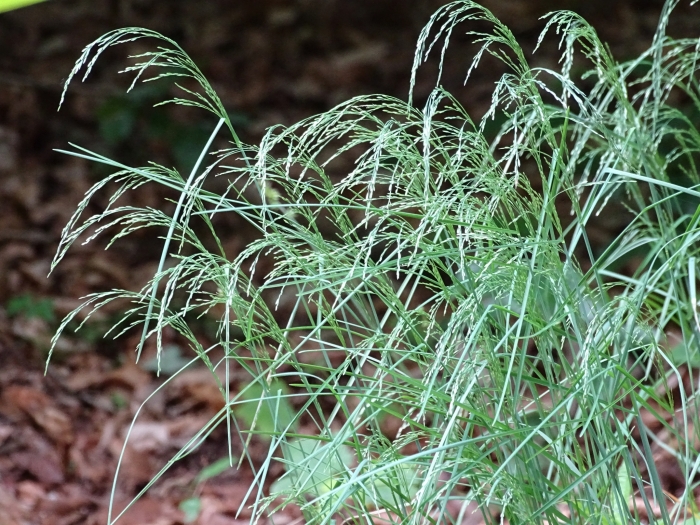Wood Bluegrass
(Poa nemoralis)
Wood Bluegrass (Poa nemoralis)
/
/

Christian Berg
CC BY 4.0
Image By:
Christian Berg
Recorded By:
Copyright:
CC BY 4.0
Copyright Notice:
Photo by: Christian Berg | License Type: CC BY 4.0 | License URL: http://creativecommons.org/licenses/by/4.0/ | Rights Holder: Christian Berg | Publisher: iNaturalist | Date Created: 2020-05-31T11:39:48-07:00 |




































Estimated Native Range
Summary
Poa nemoralis, commonly known as Wood Bluegrass, is a perennial grass that exhibits evergreen characteristics in milder climates but may be deciduous in colder regions. It is native to temperate forests and grasslands, often found in shaded areas, across the Northern Hemisphere, including Europe, the Russian Far East, Central Asia, the Middle East, and parts of the Northeastern USA. Typically, it forms loose tufts and has a more delicate, slender appearance compared to other meadow grasses, with a slightly creeping habit. The leaves are fine-textured, narrow, and taper to a pointed tip. Poa nemoralis produces inflorescences with one to five flowers, which are in bloom from June to August, offering a subtle floral display.
This species is valued for its ability to thrive in shaded conditions and is often used for understory plantings, erosion control, and as a component of woodland garden designs. It is appreciated for its ease of maintenance and ability to form a ground cover in areas where other grasses might struggle. In cultivation, Wood Bluegrass prefers moist, well-drained soils and can tolerate a range of light conditions from full sun to deep shade. While it is not known for any significant diseases or pests, its potential for invasiveness should be considered before planting, as it can spread beyond its intended area, especially in regions outside its native range.CC BY-SA 4.0
This species is valued for its ability to thrive in shaded conditions and is often used for understory plantings, erosion control, and as a component of woodland garden designs. It is appreciated for its ease of maintenance and ability to form a ground cover in areas where other grasses might struggle. In cultivation, Wood Bluegrass prefers moist, well-drained soils and can tolerate a range of light conditions from full sun to deep shade. While it is not known for any significant diseases or pests, its potential for invasiveness should be considered before planting, as it can spread beyond its intended area, especially in regions outside its native range.CC BY-SA 4.0
Plant Description
- Plant Type: Grass
- Height: 1-2.5 feet
- Width: 1-3 feet
- Growth Rate: Moderate
- Flower Color: N/A
- Flowering Season: Summer
- Leaf Retention: Evergreen
Growth Requirements
- Sun: Full Sun, Part Shade
- Water: High
- Drainage: Fast
Common Uses
Butterfly Garden, Low Maintenance
Natural Habitat
native to temperate forests and grasslands, often found in shaded areas, across the Northern Hemisphere, including Europe, the Russian Far East, Central Asia, the Middle East, and parts of the Northeastern USA
Other Names
Common Names: Wood Meadow Grass, Lund-Rapgræs, Hain-Rispengras, Hainrispengras, Lehtonurmikka, Pâturin Des Bois, Fienarola Dei Boschi, Lundrapp, Schaduwgras, Lundgröe
Scientific Names: , Poa nemoralis, Poa nemoralis var. glaucantha, Poa glauca var. glaucantha, Poa lapponica, Poa nemoralis var. nemoralis, Poa parnellii, Poa nemoralis var. firmula, Poa nemoralis var. rigidula, Poa nemoralis var. vulgaris
GBIF Accepted Name: Poa nemoralis L.